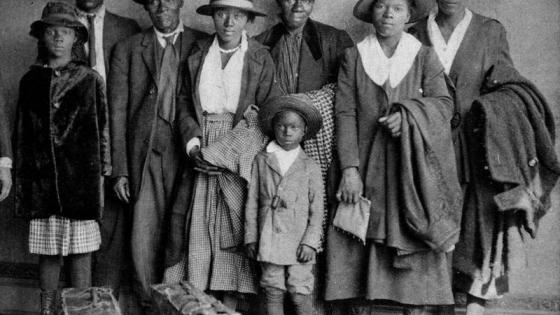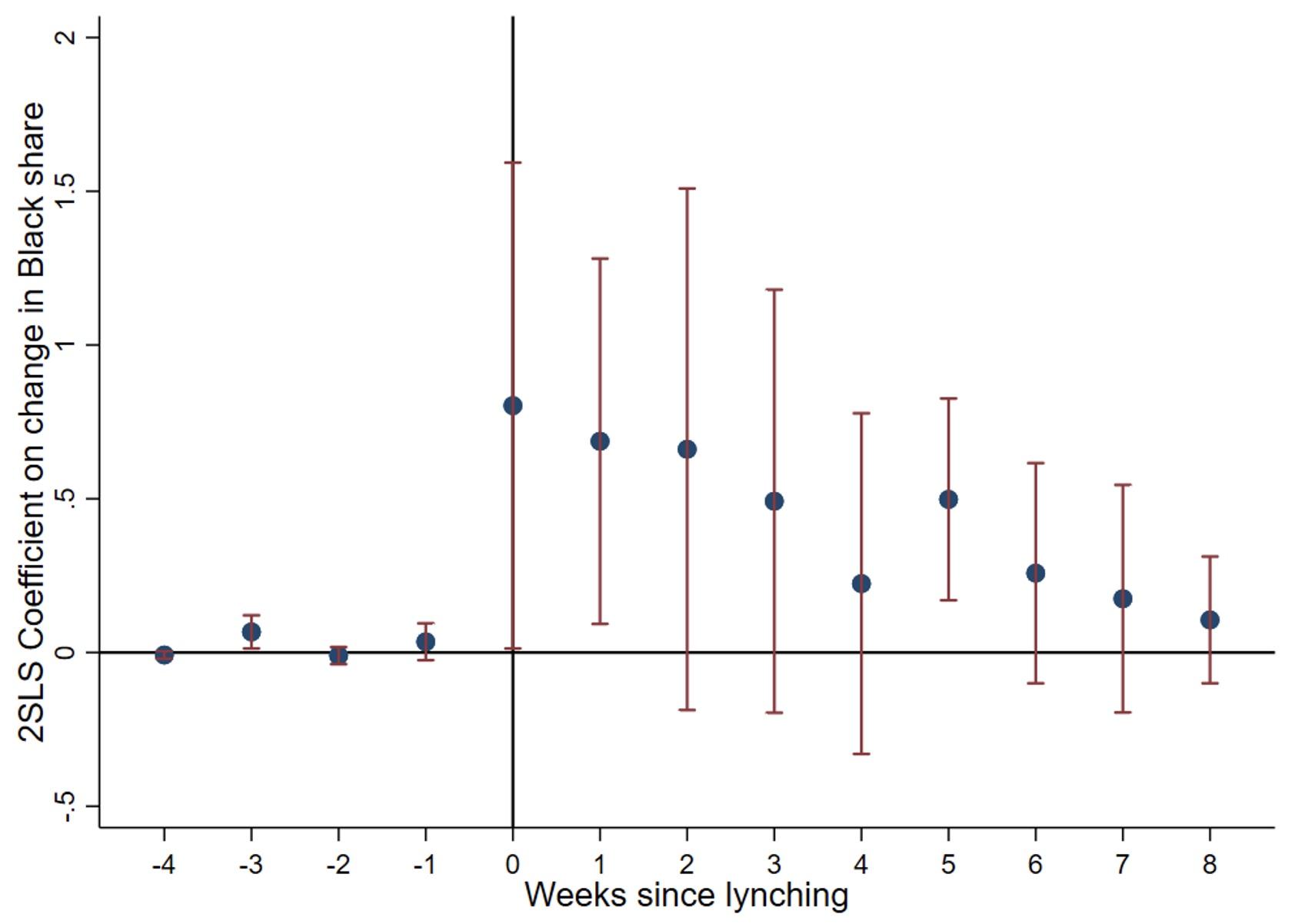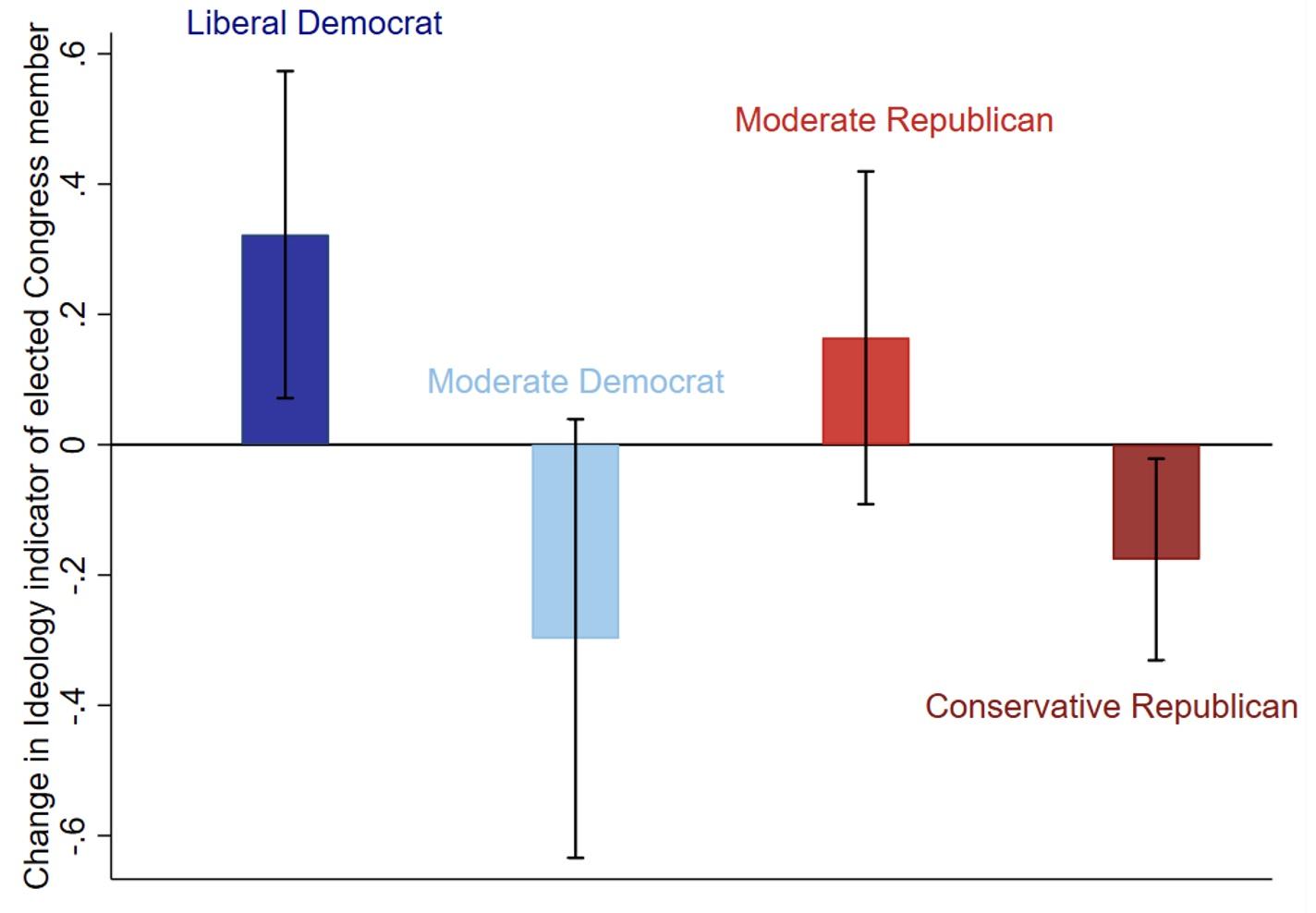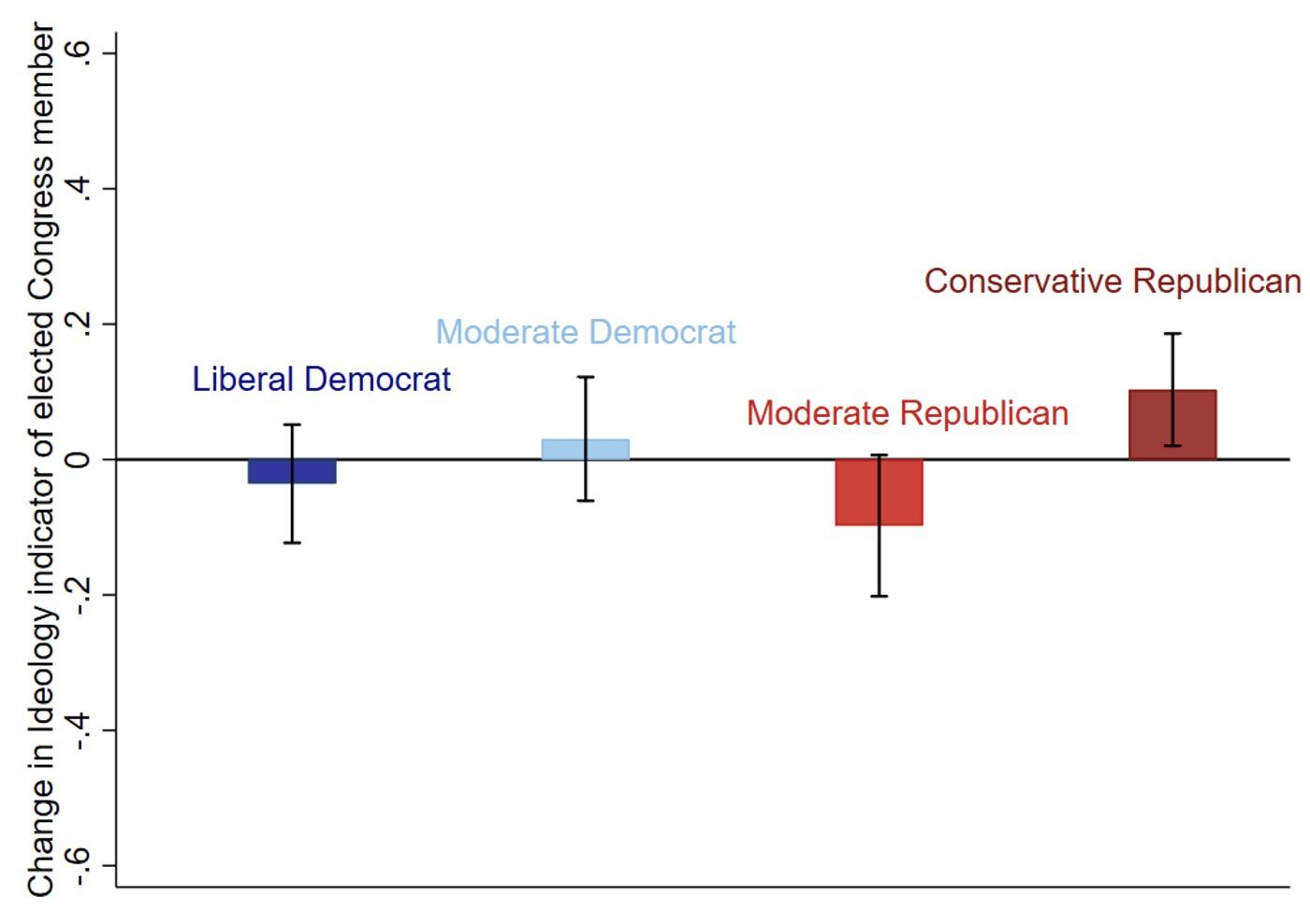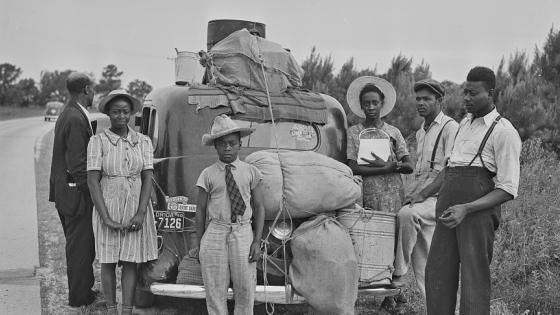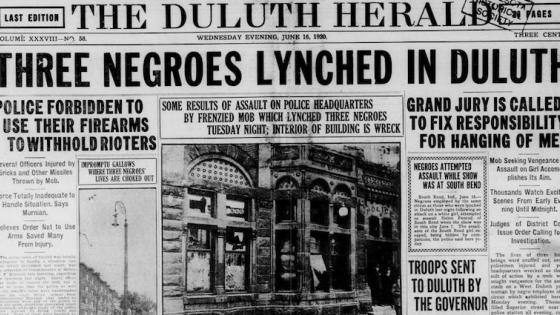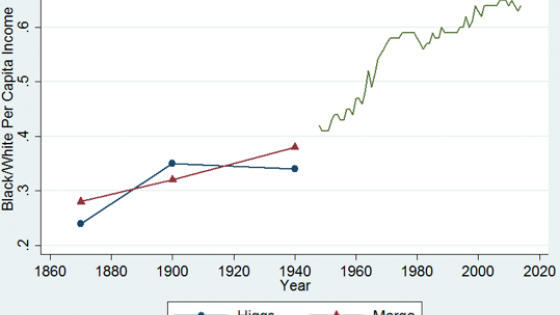Racial inequality permeates every facet of American society – from employment and schooling opportunities to intergenerational mobility to incarceration rates (Bayer and Charles 2018, Bertocchi and Dimico 2010. Chetty et al. 2020, Margo 2016). One of the potential causes of the racial gap and its unwavering persistence is the lack of political power of Black Americans, who have been denied the right to vote for a major part of American history. Oppression against African Americans was particularly strong in the US South (Cook et al. 2017). In 1944, when more than two-thirds of the African American population were still living in the region, Swedish economist and Nobel Prize winner Gunnar Myrdal hypothesised that leaving the South would enable Black people to achieve racial equality and finally gain political rights (Myrdal 1944). “There is no doubt that migration to the North and West is a tremendous force in the general amelioration of the Negro’s position,’’ wrote Myrdal in his masterpiece An American Dilemma, because “[i]t [i.e., the migration] increases the Negro vote, which might become of rising importance for national policy.’’
Precisely around the time of the publication of An American Dilemma, African Americans began to move out of the South and towards the Northern and Western regions of the US, leaving behind them the system of disenfranchisement, violence, and discrimination perpetuated by the infamous Jim Crow laws. Between 1940 and 1970, more than 4 million Black people migrated as part of a movement known as the Second Great Migration, or simply the Great Migration. One cannot fail to notice that this unprecedented migration episode coincided temporally with the growth and eventual success of the civil rights movement, which marked a turning point in the history of race relations and culminated in the passage of the Civil and Voting Rights Acts of 1964 and 1965.
It is reasonable to hypothesise a causal connection between the two developments. Most Southern legislators staunchly supported white supremacy and segregationist policies, empowered in their stance by a disenfranchised Black population. Black people in the North, on the other hand, could more freely exercise their right to vote, and pressure Northern members of Congress (Moon 1948). Grassroots organisations based in the North, such as the National Association for the Advancement of Colored People (NAACP) and the Congress of Racial Equality (CORE), played a key role in the process of enfranchisement (Lawson 1976, Sugrue 2008). Was Myrdal right? Did northward migration allow African Americans to gain political power?
Our recent paper (Calderon et al. 2021) addresses this question, studying the political effects of Black in-migration to the US North and West between 1940 and 1970. We first ask how the Great Migration affected demand for civil rights and racial equality among non-Southern voters. As a proxy of demand for civil rights, we focus on the Democratic vote share in Congressional elections. The Democratic Party was openly segregationist and stubbornly defended white supremacy in the South until the early 1960s (Kuziemko and Washington 2018, Lawson 1976). In the North and West, however, it had unambiguously become a promoter of racial equality by the end of the 1930s (Caughey et al. 2020, Schickler, 2016). To more directly measure demand for racial equality, we also consider the frequency of pro-civil rights demonstrations and the presence of local grassroots organisations in the North. Next, we investigate how Black in-migration influenced the ideology and behaviour of non-Southern members of the House on race-related issues.
We exploit variation in Black in-migration across non-Southern counties for the three decades between 1940 and 1970, building on the migration literature (Card 2001) to overcome the potential concern that Black migrants systematically moved to areas where racial attitudes were changing differentially. In particular, we combine geographic variation in settlements of Southern born African Americans living outside the US South prior to the Great Migration with time-series variation in out-migration across Southern states in each decade between 1940 and 1970. This strategy allows us to predict the number of Black migrants from different Southern states received by each non-Southern county after 1940.
We find that Black in-migration had a strong, positive effect on the vote share of the Democrats in Congressional elections, the frequency of pro-civil rights protests organised by CORE, and the presence of local NAACP chapters. Our electoral results are quantitatively large and imply that a one percentage point increase in the population share of Black Americans raised the Democratic vote share by 1.8 percentage points, or 4% relative to the baseline mean. Even under the aggressive assumption that all Black migrants immediately voted for the Democratic Party upon arrival, support for Democrats must have increased among white Northern residents because of Black inflows. Indeed, using a subset of the data on pro-civil rights demonstrations, which reports the race of participants, we document that both Black and white individuals joined CORE demonstrations. Historical survey data provides additional evidence that white respondents living in states with larger Black inflows between 1940 and 1960 held more favourable views on race relations and were more likely to vote for the Democrats.
To understand which segments of the white electorate became more supportive of civil rights, we explore heterogeneity in our results by historical county characteristics. CORE demonstrations were more frequent in counties where a liberal cross-race coalition that combined political and economic goals was more likely to emerge. This was the case in counties where the share of whites employed in manufacturing was higher, where the presence of the Congress of Industrial Organizations (CIO) – the main force behind industrial unionism – was stronger, and where elections were more competitive. Moreover, and consistent with labour unions supporting a cross-race alliance only when labour markets were tight, protests increased only where labour demand was stronger.
We also explore the possibility, raised by Myrdal, that the Great Migration increased support for civil rights among socially progressive whites by increasing the salience of the “race problem” and fostering their demand for racial equality. As Myrdal noted in The American Dilemma, since “the average Northerner does not understand the reality and the effects of such [Southern] discriminations… [t]o get publicity is of the highest strategic importance to the Negro people.” In line with this idea, CORE protests were concentrated in counties with a history of lower racial discrimination.
To more rigorously test the “information mechanism” envisioned by Myrdal, we compiled a list of all known lynchings committed by white offenders against Black Americans in the US South between 1940 and 1964. A series of event studies shows that, in the weeks following a lynching, local Northern newspapers were more likely to report the episode in counties that had received more African American migrants in previous years. Results are driven by white newspapers, and heightened reporting lasts for more than one month after a lynching. These patterns are displayed in Figure 1. Here, we plot the effects of the change in the share of Black individuals in the county population on the probability that non-Southern local newspapers reported a Black lynching, zooming in on the 12 weeks around the event (denoted by the vertical line).
Figure 1 Reporting of Southern Black lynchings in Northern newspapers
Notes: The figure plots 2SLS coefficients (with corresponding 95% intervals) on the 1940-1960 change in the Black share of the county population in county-week level regressions. The dependent variable is a dummy equal to one if any mention about a Black lynching in the US South appeared in newspapers of the (non-southern) county in each week. Week 0 refers to the week when the lynching occurred. The figure is obtained by estimating regressions that control for state and lynching episode fixed effects, and are weighed by 1940 county population. Standard errors are clustered at the county level.
In the second part of the paper, we turn to the stance on racial issues of legislators representing non-Southern congressional districts. To measure legislators’ racial ideology, we use the scores constructed by Bateman et al. (2017), which are based on past voting behaviour on civil rights bills. Over time, districts that received more African Americans were represented by legislators with a more liberal ideology on racial issues, who were also more likely to take active steps to promote civil rights bills. These average effects, however, mask substantial heterogeneity, as legislators of either party became increasingly polarised on racial issues.
Figure 2 illustrates such polarisation patterns, by plotting the effects of Black migration on the probability that a district was represented by a legislator with a given political orientation. In the 1940s, Black inflows triggered a general shift towards a more progressive racial ideology within both parties (Panel A). In line with a between-party adjustment, the probability of electing a (liberal) Democrat increased more than that of electing a (moderate) Republican. In the 1950s, instead, most of the action came from changes within the GOP, with legislators moving to the right (Panel B). Since the ideological shift during the 1940s is quantitatively larger than that occurring during the 1950s, on average, legislators’ ideology moved to the left. However, when inspecting these dynamics more carefully, polarisation becomes evident.
Figure 2 Black in-migration and ideology of Northern legislators
A) 1940s
B) 1950s
Notes: Each bar reports 2SLS coefficients (with corresponding 95% confidence intervals) for the effect of changes in the Black share of Congressional District population on the change in the probability of electing a member of the House with the corresponding political orientation between Congress 78 and Congress 82 (Panel A) and between Congress 82 and Congress 88 (Panel B). The ideology indicators are based on the scores computed in Bateman et al. (2017) using past voting behavior on civil rights bills.
Our paper complements the existing literature on the Great Migration, which has emphasised the long-run negative impact that this episode had on both racial residential segregation and economic mobility for African Americans (Akbar et al. 2019, Derenoncourt 2019). Our findings, instead, paint a more nuanced picture. They indicate that, as predicted by Gunnar Myrdal in 1944, Black migration out of the South was instrumental for the development of the civil rights movement, and for the concomitant political changes that led to progress towards racial equality in the United States.
Our results also have broader implications for intergroup relations in diverse societies (Alesina et al. 2013, Collins and Zimran 2019, Fouka et al. 2020). Common goals – as in the case of economic and social liberalism uniting organized labour and civil rights activists – can facilitate the formation of cross-group coalitions. Underlying characteristics of individuals also matter – exposure to a discriminated minority and information on discrimination can foster positive change for majority members, especially among those who are already more open to diversity.
References
Akbar, P A, S Li, A Shertzer and R Walsh (2019), "Segregated housing markets and the erosion of black wealth: New evidence from pre-war cities", VoxEU.org, 31 August.
Alesina, A, J Harnoss and H Rapoport (2013), "Immigration, diversity, and economic prosperity", VoxEU.org, 22 August.
Bateman, D A, J D Clinton, and J S.Lapinski (2017), “A House Divided? Roll Calls, Polarization, and Policy Differences in the US House, 1877-2011”, American Journal of Political Science 61 (3): 698-714.
Bayer, P and K K Charles (2018), “Divergent Paths: A New Perspective on Earnings Differences between Black and White Men since 1940”, The Quarterly Journal of Economics 133(3): 1459-1501.
Bertocchi, G and A Dimico (2010), "The historical roots of inequality", VoxEU.org, 14 November.
Calderón, A, V Fouka, and M Tabellini (2021), “Racial Diversity and Racial Policy Preferences: the Great Migration and Civil Rights”, NBER Working Paper 28965.
Card, D (2001), “Immigrant Inflows, Native Outflows, and the Local Labor Market Impacts of Higher Immigration”, Journal of Labor Economics 19(1): 22-64.
Caughey, D, M C Dougal, and E Schickler (2020), “Policy and Performance in the New Deal Realignment: Evidence from Old Data and New Methods”, The Journal of Politics 82(2): 494-508.
Chetty, R, H Nathaniel, M R Jones and S R Porter (2020), “Race and Economic Opportunity in the United States: An Intergenerational Perspective”, The Quarterly Journal of Economics 135(2): 711-783.
Collins, W J and A Zimran (2019), "The many John Kellys: Economic assimilation of the Famine Irish in America", VoxEU.org, 19 January.
Cook, L, T Logan and J Parman (2017), "Racial segregation and Southern lynching", VoxEU.org, 14 October.
Derenoncourt, E (2019), “Can You Move to Opportunity? Evidence from the Great Migration.” Working Paper.
Fouka, V, S Mazumder and M Tabellini (2020), "From immigrants to Americans: Race and assimilation in the age of mass migration", VoxEU.org, 27 March.
Kuziemko, I and E Washington (2018), “Why Did the Democrats Lose the South? Bringing New Data to an Old Debate”, American Economic Review 108(10): 2830-2867.
Margo, R (2016), "The persistence of racial inequality in the US", VoxEU.org, 8 June.
Moon, H L (1948). Balance of Power: The Negro Vote, Greenwood Publishing Group.
Myrdal, G (1944). An American Dilemma: The Negro Problem and Modern Democracy, Harper and Row.
Schickler, E (2016). Racial Realignment: The Transformation of American Liberalism, 1932-1965, Princeton University Press.
Sugrue, T J (2008). Sweet Land of Liberty: The Forgotten Struggle for Civil Rights in the North, Random House.
